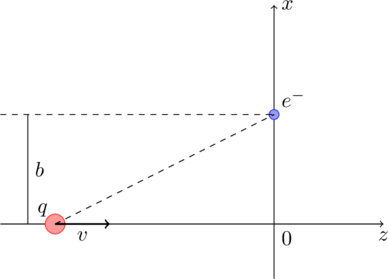Madey が1971年にJ. Appl. Phys. に発表した論文について、さらに続ける。
Weizsäcker-Williams Method
Madeyは、電子と周期磁場(アンジュレータ)の相互作用を、電子と仮想光子の相互作用に置き換えた。これは、Weizsäcker-Williams method(以下WWMと略す)と呼ばれる手法である。
Jackson の教科書(Chap. 15)には、WWMによる制動放射の解析が示されている。相対論的エネルギーを持った電子が物質に入射すると、電子は主に制動放射 (Bremsstrahlung)によってエネルギーを失う。電子が物質中の原子核で散乱される時、減速したり向きを変えられる(加速度を受ける)ことに より電磁波の形でエネルギーを放射する現象である。この時、電子の静止系から見れば、原子核の電場は、前方から光速に近い速度で進んでくる電磁場(光)パ ルスと等価と考えられる。これが、WWMの考え方だ。WWMによれば、制動放射は電子と仮想光子(電磁場パルス)のコンプトン散乱として取り扱うことがで きる。

上図は、WWMによる制動放射の説明である。電子(![]() )の静止系において原子核(
)の静止系において原子核(![]() )が速度(
)が速度(![]() )で運動している様子を示している。
)で運動している様子を示している。![]() はインパクトパラメータである。原子核が原点(
はインパクトパラメータである。原子核が原点(![]() )を通る時刻を
)を通る時刻を![]() とすると、電子が感じる電場、磁場はそれぞれ次式で表される(Jackson はcgs単位系だが、SI単位系に直してある)。
とすると、電子が感じる電場、磁場はそれぞれ次式で表される(Jackson はcgs単位系だが、SI単位系に直してある)。
![Rendered by QuickLaTeX.com \[ E_x(t) = \frac{q}{4\pi\varepsilon_0} \frac{\gamma b}{(b^2 + \gamma^2 v^2 t^2)^{3/2}} \]](https://e-beam.sakura.ne.jp/physics/wp-content/ql-cache/quicklatex.com-1366652c20d8c8c753944a96e0c37eb6_l3.png)
![]()
![]()
![]() の時、
の時、![]() と
と![]() は、真空中の光が作る電磁波と等価になる。この手法は、1924年のFermiのアイデアを、1934年に Weizsäcker、Williams がそれぞれ、相対論効果の補正を施して正確な計算ができるようにしたものである。
は、真空中の光が作る電磁波と等価になる。この手法は、1924年のFermiのアイデアを、1934年に Weizsäcker、Williams がそれぞれ、相対論効果の補正を施して正確な計算ができるようにしたものである。
Madey の論文では、WWMを使った制動放射の解析にならって、電子と仮想光子(電子の静止系から見たアンジュレータ磁場)の相互作用を解析している。論文タイト ルの”Stimulated Emission of Bremsstrahlung in a Periodic Magnetic Field”は、この意味で論文の内容と一致する。
余談だが、いまやFEL研究者として知られている Kwang-Je Kimが、Madey の論文と同じ時代に”Improved Weizsäcker-Williams Method and Its Application to Lepton and W-Boson Pair Production” という論文を Physical Review D に発表している。論文の書き出しに以下の記述がある。WWM の有用性を簡潔に示した文章として引用しておきたい。
Some of the cross sections which involve one photon exchange can be quite complicated. The best example is the calculation of the W pair production, ![]() , which involves threefold integration of roughly 3000 terms. With the advancement in the modern computer technique, even such a complicated calculation can be handled easily. However, it is often desirable to have a simple expression which shows all the gross features of the problem, such as the dependence of the cross section on the incident energy, outgoing energy, angle, mass, magnetic moment, radius of the target, etc. The way in which one can do this quickly was originally suggested by Fermi in 1924, who noted the similarity between the electromagnetic fields of a rapidly moving charged particle and a pulse of radiation. Based on this observation, Weizsäcker and Williams showed independently in 1934
, which involves threefold integration of roughly 3000 terms. With the advancement in the modern computer technique, even such a complicated calculation can be handled easily. However, it is often desirable to have a simple expression which shows all the gross features of the problem, such as the dependence of the cross section on the incident energy, outgoing energy, angle, mass, magnetic moment, radius of the target, etc. The way in which one can do this quickly was originally suggested by Fermi in 1924, who noted the similarity between the electromagnetic fields of a rapidly moving charged particle and a pulse of radiation. Based on this observation, Weizsäcker and Williams showed independently in 1934
(中略)
The above formula, which is known as the pseudo-photon flux of the classical Weizsäcker -Williams (W. W. ) method, has enjoyed wide applications in processes involving one photon exchange in the past because of its conceptual and mathematical simplicity.
http://dx.doi.org/10.1103/PhysRevD.8.3109
SLAC の preprint server でも読める。WWMのオリジナル、Fermi、Weizsäcker、Williams の論文もreferences に載っている。
http://www.slac.stanford.edu/cgi-wrap/getdoc/slac-pub-1030.pdf
さらなる余談だが、ベルリンの壁崩壊を挟んだ10年間ドイツの大統領を務め、今年1月31日に94歳で亡くなったヴァイツゼッカー(リヒャルト・カール・フライヘア・フォン・ヴァイツゼッカー)は、WWM で知られる Weizsäcker(カール・フリードリヒ・フライヘア・フォン・ヴァイツゼッカー)の兄である。WWMのWeizsäckerも94歳まで生きた(2007年逝去)のを見ると長寿の家系だったのかもしれない(物理とは関係ないことですが)。
